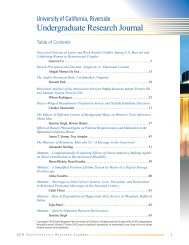UC Riverside Undergraduate Research Journal
UC Riverside Undergraduate Research Journal
UC Riverside Undergraduate Research Journal
Create successful ePaper yourself
Turn your PDF publications into a flip-book with our unique Google optimized e-Paper software.
Computational Prediction of Association Free Energies for the C3d-CR2 Complex and Comparison to Experimental Data<br />
Alexander S. Cheung<br />
methionine of C3d which is an artifact added by the protein<br />
expression system. One of the chains in the PDB file, chain<br />
C, a CR2 molecule that is not in contact with C3d, was also<br />
removed. This is because chain C is irrelevant in this study,<br />
since it is known that CR2 behaves as a monomer in solution<br />
[7]. What remains is a C3d molecule, consisting of 306 amino<br />
acids, in contact with a CR2 molecule, consisting of 129<br />
amino acids. We used the program SPDBV (Swiss Protein<br />
Data Bank Viewer) [17], version 3.7, to renumber the amino<br />
acids and atoms in the PDB file (displacing every atom by<br />
-1, resulting in a total of 435 amino acids consisting of 3399<br />
atoms) and subsequently separate the two components of the<br />
complex to create one PDB file with C3d alone and one PDB<br />
file with CR2 alone. After separation, amino acids and atoms<br />
were renumbered for CR2 to begin at residue 307 and atom<br />
2413. Thus three PDB files constitute the final output of<br />
this step: one PDB file consisting of the C3d-CR2 complex,<br />
one consisting of C3d, and one consisting of CR2. These<br />
three PDB files are considered the “parent” PDB files. By<br />
generating each of the component parent PDB files from the<br />
complex parent PDB file in this way, it is ensured that the<br />
atomic coordinates of each component of the complex in<br />
each of their respective component files are identical to their<br />
atomic coordinates in the complex file. This is crucial for<br />
the accurate calculation of free energy differences. Finally,<br />
we used the program WHATIF [18] to add the missing<br />
C-terminal oxygen atom of C3d in the C3d-CR2 complex.<br />
The third step (Fig. 2) was the construction of the 23<br />
specific mutants. This is done using WHATIF, a home-made<br />
python script [19] that calls WHATIF, the three parent PDB<br />
files, and three input text files, each of which list the amino<br />
acid substitutions to be made in one of the three parent PDB<br />
files. Each of the 23 mutations had to be performed twice:<br />
once on the complex PDB file and again on the individual<br />
component file containing the mutation(s). Thus, the script<br />
was run three times, each time using as inputs one of the<br />
three parent PDB files and its corresponding input text file.<br />
For the purpose of consistency, each of the parent PDB files<br />
was also run through WHATIF manually without making any<br />
mutations. The outputs of this step are 23 mutant complex<br />
PDB files, 9 mutant C3d PDB files, 14 mutant CR2 PDB<br />
files, and the three parent PDB files (49 PDB files total).<br />
These 49 PDB files comprise 24 sets (parent and 23 mutants)<br />
of 3 PDB files each (C3d, CR2, complex).<br />
The fourth step (Fig. 2) was the removal of a<br />
WHATIF-specific header added to each PDB file in the<br />
last step, and the change of the nomenclature of C-terminal<br />
oxygens from O’’, which is recognizable by WHATIF, to<br />
OXT, which is recognizable by PDB2PQR (to be used in<br />
the next step). These two tasks are accomplished using<br />
home-made python scripts [19].<br />
The fifth step (Fig. 2) involved the use of the<br />
program, PDB2PQR [20] 1.2.1, to prepare the coordinate<br />
PDB files for use with APBS (see below). Through the use<br />
of a home-made python script, each of the 49 PDB files was<br />
run through PDB2PQR. The outputs were 49 files in PQR<br />
format, each containing three-dimensional atomic coordinate<br />
data as well as charge and van der Waals radii assigned<br />
according to the PARSE parameter file [20]. The default<br />
options for debumping and hydrogen bond optimization<br />
were left on. Debumping refers to local optimization to<br />
eliminate unfavorable van der Waals clashes (overlap or<br />
partial overlap of atomic radii). The hydrogen bond network<br />
optimization algorithm assures that optimal hydrogen bonds<br />
are present by 180 o -flipping the rings of histidine or of planar<br />
amine groups of glutamines or asparagines. This option is<br />
necessary because electron densities from X-ray diffraction<br />
data do not discriminate between the 0 o - and 180 o -flip states<br />
of these amino acid side chains.<br />
The purpose of steps 1-5 described above is to<br />
create the proper input files for use with the program<br />
APBS (Adaptive Poisson-Boltzmann Solver) [22]. The<br />
sixth step was calculation of electrostatic potentials using<br />
Figure 3. Hypothetical thermodynamic cycle. Horizontal processes<br />
represent association in vacuum (top) and in solution (bottom).<br />
Vertical processes represent solvation of the components (left)<br />
and of the complex (right). Electrostatic potential surfaces are<br />
visualized at ±30 kT/e for association in vacuum (top) and at ±1<br />
kT/e in solution (bottom).<br />
16 <strong>UC</strong>R Un d e r g r a d u a t e Re s e a r c h Jo u r n a l














